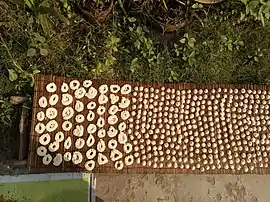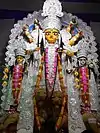Gohona Bori
Gohona Bori (Bengali: গহনা বড়ি) is a dried dal dumpling. It is popular in Bengali cuisine. It is a well known food item in Purba Medinipur.[1] It is also known as Naksha Bori. It is made with black lentil, Poppy seed and various spices. The woman of the house made the dish. In 2016, IIT Kharagpur applied to get the geographical Indication for Gohona Bori.[2]
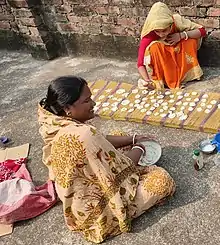
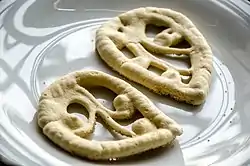 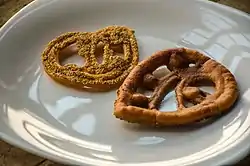 Gohona Bori | |
| Alternative names | Naksha Bori |
|---|---|
| Type | Dumpling |
| Place of origin | India |
| Region or state | Purba Medinipur, West Bengal |
| Associated national cuisine | India |
| Main ingredients | Cowpea, Poppy seed and various type of Spices |
| Variations | Bori |
History
It is an age-old dish of Bengal. Before the arrival of the British in India, poppy seed was not used in Gohona Bori. After the Battle of Palashi, the British discovered a market of illegal opium in China. British forced the farmers of the Rarh region of Bengal to cultivate poppy and extorting large amounts of opium from them into China. Poppy seeds were dropped after the opiate was extracted. In the past, poppy seeds became the cooking material of Bankura, Birbhum, Bardhaman and Midnapore districts. Thus the poppy seeds are used in Gohona Bori in Midnapore.[3]
In 1930, Seba Maiti, a student of Shantiniketan presented Gohona Bori to Rabindranath Tagore which was made by her mother, Hirnmayi Debi, and grandmother, Sheratakumari Debi. Tagore was so attracted to Bori that he wrote them a letter seeking permission to preserve the photographs of Gohona Bori at the Art Building of Shantiniketan.[4] As a result, Gohona Bori gained popularity as a sign of art. Abanindranath Tagore considered it to be an art. So he considered the thought of baking it or eating it was considered an act of destruction.[4] He noted a similarity with historical artwork and arranged an exhibition. Nandalal Bose described it as a jewel of the Bengali mother's jewelry box. He expressed his desire to publish a book on it.[4]
Gohona Bori were exhibited in the 59th session of Indian National Congress held in Kalyani in 1954. In 1990, the West Bengal government took part in a food festival organized by the women of Tamluk's Gohona Bori maker.[5] They prepared Gohona Bori in front of thousands of curios men in Kolkata. In 1995 a Gohona Bori marketing group was established in Tamluk.
Design
Each cook chooses their own design. Triangles, circles and squares are common along with other geometric designs such as shells, lotus, cats, cactus, peacock, owls, poultry and butterflies .[5]
References
- ":::::: Daricha Foundation ::::::". www.daricha.org. Retrieved 2019-03-12.
- IANS (2016-07-31). "IIT Kharagpur facilitating filing of GI application for 'Goyna Bori'". Business Standard India. Retrieved 2019-03-12.
- "How British greed spurred the creation of one of Bengal's most loved dishes". The Indian Express. 2016-03-31. Retrieved 2019-03-12.
- Ray, Utsa (2015-01-05). Culinary Culture in Colonial India. Cambridge University Press. ISBN 9781107042810.
- Bhowmik, Arindam. Medinikatha - Purba Medinipur (Midnapore), Tourism & Archaeology (মেদিনীকথা - পূর্ব মেদিনীপুর, পর্যটন ও পুরাকীর্তি): Combination of History, Heritage, Tourism, Culture of East Midnapore (in Bengali). Arindam Bhowmik. ISBN 9788193189238.

